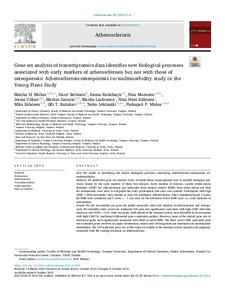Hae
Aineistot 1-10 / 11
Long-term tracking and population characteristics of lipoprotein (a) in the Cardiovascular Risk in Young Finns Study
<p>Background and aims</p><p>Lipoprotein (a) (Lp(a)) is a causal risk factor for cardiovascular diseases and its levels are under strict genetic control. Therefore, it is hypothesized that the concentration of Lp(a) remains ...
Weight gain in infancy and markers of cardiometabolic health in young adulthood
Aim We studied whether repeatedly measured weight gain from birth up to age 2 years associated with cardiometabolic health in young adulthood. Methods Using the data collected in the longitudinal Special Turku Coronary ...
Sydän- ja verisuonitautien ehkäisy kannattaa aloittaa jo vauvasta - STRIP-tutkimus näyttää miksi ja miten
Satunnaistetussa STRIP-tutkimuksessa 562 tervettä lasta sai tyydyttyneen rasvan saannin vähentämiseen tähtäävää ravitsemusneuvontaa kahdeksan kuukauden iästä alkaen 20 vuoden ikään asti, ja 545 saman ikäistä lasta seurattiin ...
Genetic and observational evidence: No independent role for cholesterol efflux over static high-density lipoprotein concentration measures in coronary heart disease risk assessment
<p>Background <br></p><p>Observational findings for high-density lipoprotein (HDL)-mediated cholesterol efflux capacity (HDL-CEC) and coronary heart disease (CHD) appear inconsistent, and knowledge of the genetic architecture ...
Does better education mitigate risky health behavior? A mendelian randomization study
<p><br></p><p>Education and risky health behaviors are strongly negatively correlated. Education may affect health behaviors by enabling healthier choices through higher disposable income, increasing information about the ...
An Infancy-Onset 20-Year Dietary Counselling Intervention and Gut Microbiota Composition in Adulthood
The randomized controlled Special Turku Coronary Risk Factor Intervention Project (STRIP) has completed a 20-year infancy-onset dietary counselling intervention to reduce exposure to atherosclerotic cardiovascular disease ...
IDO activity forecasts obesity in males and premenopausal females in a 10-year follow-up study:The Cardiovascular Risk in Young Finns Study
<p>Background and aims: Indoleamine 2,3-dioxygenase (IDO) is an intracellular enzyme associated with artery wall inflammation. Previous studies have verified correlation between IDO activity and early signs of atherosclerosis especially in females. We aimed to elucidate the relationship between an estimate of IDO activity and atherosclerotic risk factors related to non-alchohol-fatty liver (NAFLD) in a 6- and 10-year follow-up.<br></p><p>Methods: Estimates of IDO activity along with complete risk factor data were measured from females (n = 506; age 24-39) and males (n = 421; age 24-39) in 2001. Risk factor measurements were conducted again in 2007 and 2011. Statistical examinations were carried out by Pearson correlation and risk ratio analysis.<br></p><p>Results: In females, age-adjusted IDO correlated with body mass index (BMI) (p = 0.0008), waist (p = 0.0009), C reactive protein (CRP) (p = 0.0014) and logarithmically modified triglycerides (p = 0.0488) in 2007. Correlation remained significant with BMI (p = 0.0007) and waist (p = 0.0063) in 2011. In males, age-adjusted IDO correlated with waist (p = 0.0367) and high-density lipoprotein cholesterol (HDL-C) (p = 0.0489) in 2007. Correlation remained significant with HDL-C (p = 0.0348) in 2011. In risk ratio analysis, relationship between IDO and obesity was confirmed in females after 10 years (RR = 1.026, p = 0.0147, 95% CI) and in males after 6 and 10 years (RR = 1.019, p = 0.0091, 95% CI and RR = 1.015, p = 0.0404, 95% CI, respectively) when the data was adjusted for age and BMI.Conclusions: IDO activity correlated with obesity and factors related to NAFLD, namely obesity of visceral type, hypertriglyceridemia and CRP (in females), well-characterized risk factors for diabetes and atherosclerosis in 6 and 10-year follow-up in males and premenopausal females.</p>...
Metabolic trajectories in childhood and adolescence: Effects on risk for schizophrenia
<p>Abnormal glucose and lipid metabolism is common in antipsychotic-naive first-episode patients with schizophrenia, but it is unclear whether these changes can already be seen in premorbid or prodromal period, before the first psychotic episode. We examined insulin, total cholesterol, low-density lipoprotein (LDL) cholesterol, high-density lipoprotein (HDL) cholesterol, and triglyceride trajectories in children and adolescents (9-18 years old), who were later diagnosed with schizophrenia, any non-affective psychosis (NAP) or affective disorder (AD). The study population consisted of a general population-based cohort "The Cardiovascular Risk in Young Finns Study", started in 1980 (n=3596). Psychiatric diagnoses were derived from the Health Care Register up to the year 2018. Multivariate statistical analysis indicated no significant differences in insulin or lipid levels in children and adolescents who later developed schizophrenia (n=41) compared to the cohort control group (n=3202). In addition, no changes in these parameters were seen in the NAP (n=74) or AD (n=156) groups compared to the controls, but lower triglyceride levels in childhood/adolescence associated with earlier diagnosis of psychotic disorder in the NAP group. Taken together, our results do not support any gross-level insulin or lipid changes during childhood and adolescence in individuals with later diagnosis of schizophrenia-spectrum disorder. Since changes in glucose and lipid metabolism can be observed in neuroleptic-naive patients with schizophrenia, we hypothesize that the more marked metabolic changes develop during the prodrome closer to the onset of the first psychotic episode. The findings have relevance for studies on developmental hypotheses of schizophrenia.</p>...
Gene set analysis of transcriptomics data identifies new biological processes associated with early markers of atherosclerosis but not with those of osteoporosis: Atherosclerosis-osteoporosis co/multimorbidity study in the Young Finns Study
<p>Aim<br></p><p>We aimed at identifying the shared biological processes underlying atherosclerosis-osteoporosis co/multimorbidity.</p><p>Methods</p><p>We performed gene set analysis (GSA) of whole-blood transcriptomic ...
Birth weight, adult weight, and cardiovascular biomarkers: Evidence from the Cardiovascular Young Finns Study
This study quantifies the causal effect of birth weight on cardiovascular biomarkers in adulthood using the Cardiovascular Risk in Young Finns Study (YFS). We apply a multivariable Mendelian randomization (MVMR) method ...









